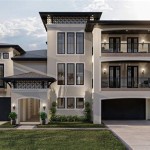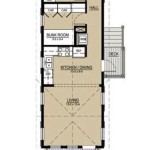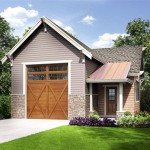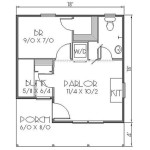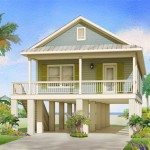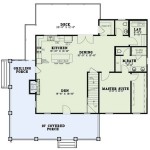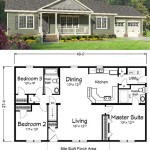Tiny Homes Floor Plans With Loft: Maximizing Space and Functionality
The allure of tiny home living continues to grow, driven by factors such as affordability, minimalist lifestyles, and reduced environmental impact. A prevalent feature in many tiny home designs is the inclusion of a loft, which cleverly utilizes vertical space to create additional living areas without expanding the overall footprint. Tiny home floor plans with lofts offer a compelling solution for those seeking to downsize without sacrificing essential amenities and comfortable living spaces. This article delves into the multifaceted aspects of these floor plans, examining their benefits, design considerations, different loft types, and practical implementations.
Tiny homes, typically defined as dwellings under 500 square feet, require innovative design strategies to optimize every inch of available space. Incorporating a loft often proves to be the most efficient way to achieve this. The loft area can serve as a bedroom, storage space, office, or even a second living area, depending on the homeowner's needs and preferences. By elevating a specific function, the main floor area can remain more open and uncluttered, contributing to a greater sense of spaciousness. The appeal extends beyond mere functionality; the loft often adds a unique architectural element and a cozy, secluded feel to the tiny home.
Key Benefits of Lofted Tiny Home Designs
The decision to incorporate a loft into a tiny home floor plan stems from a variety of advantages. These extend beyond the simple addition of square footage, impacting the overall livability and functionality of the dwelling.
Maximizing Usable Space: The primary benefit of a loft is its efficient use of vertical space. In a tiny home, where every square foot counts, the ability to double or even triple the usable area is invaluable. A lofted bedroom, for example, frees up the main floor for a living area, kitchen, and bathroom, creating distinct zones within the limited confines of the home. This segregation of space allows for greater privacy and functionality, improving the overall living experience.
Cost-Effectiveness: Building upwards, rather than outwards, is generally more cost-effective. Adding a loft typically requires less material and labor than expanding the foundation and overall footprint of the house. This can translate to significant savings during the construction phase, making tiny home ownership more accessible to those on a budget. Furthermore, a smaller footprint often results in lower property taxes and utility bills.
Enhanced Design Flexibility: Incorporating a loft introduces design flexibility, making the tiny home adaptable to various lifestyles and needs. The loft space can be customized to serve different purposes over time. For example, a loft initially used as a bedroom can later be converted into a home office or guest room as the homeowner's circumstances change. This adaptability ensures that the tiny home remains a functional and comfortable living space for years to come.
Design Considerations for Tiny Home Lofts
Designing a functional and comfortable loft requires careful consideration of several factors. These factors relate to accessibility, safety, building codes, and the overall aesthetic of the tiny home.
Accessibility: The method of accessing the loft is a crucial design consideration. Common options include ladders, stairs, and alternating tread stairs. Ladders are the most space-efficient but can be challenging for individuals with mobility issues or those carrying items to and from the loft. Stairs offer greater comfort and safety but occupy more floor space. Alternating tread stairs provide a compromise between space efficiency and ease of use. The chosen method should be practical, safe, and compliant with local building codes. It is crucial to assess the homeowner's physical capabilities and lifestyle when making this decision.
Headroom: Headroom is another critical factor that significantly impacts the usability of the loft. Adequate headroom is essential for comfortable movement and prevents feelings of claustrophobia. Building codes typically specify minimum headroom requirements for habitable spaces. It's important to note that achieving sufficient headroom may necessitate a taller overall structure, which could affect construction costs and potentially violate height restrictions in certain areas. Careful planning and adherence to building codes are crucial to ensure a safe and comfortable loft space.
Safety Measures: Safety is paramount in loft design. Guardrails or railings are essential to prevent accidental falls. The height and construction of these barriers must comply with local building codes. Furthermore, proper ventilation and fire safety measures are crucial. The loft should have adequate ventilation to prevent the buildup of stale air and condensation. Smoke detectors and fire extinguishers should be readily accessible in both the loft and the main living area.
Building Codes and Regulations: Compliance with local building codes and regulations is essential. These codes often specify minimum ceiling heights, emergency egress requirements, and structural requirements for lofts. Failure to adhere to these regulations can result in fines, delays, or even the inability to legally occupy the tiny home. It is advisable to consult with a qualified architect or builder who is familiar with local building codes to ensure that the loft design meets all applicable requirements.
Exploring Different Types of Lofts in Tiny Homes
Lofts in tiny homes are not a one-size-fits-all solution. They can be designed and configured in various ways to suit different needs and preferences. Understanding the different types of lofts can help homeowners make informed decisions about their tiny home design.
Sleeping Lofts: A sleeping loft is the most common type of loft in tiny homes. Its primary function is to provide a dedicated sleeping area, freeing up valuable space on the main floor. Sleeping lofts typically feature a low ceiling height, adequate only for sitting or lying down. Access is usually via a ladder or narrow staircase. The minimalist design focuses on providing a comfortable and private sleeping space. Windows are often incorporated for natural light and ventilation.
Storage Lofts: Storage lofts are designed specifically for storing items, such as seasonal clothing, holiday decorations, or personal belongings. These lofts often have limited headroom and are accessed via a ladder or pull-down stairs. The design prioritizes storage capacity and accessibility. Shelving, bins, and other storage solutions are typically incorporated to maximize the use of available space.
Living Space Lofts: Living space lofts serve as additional living areas, such as a home office, reading nook, or entertainment space. These lofts typically have higher ceilings than sleeping lofts, allowing for more comfortable movement and extended periods of use. Access is usually via stairs or alternating tread stairs. The design prioritizes comfort and functionality, incorporating features such as desks, chairs, and entertainment systems. Windows are essential for natural light and ventilation.
Split Lofts: Split lofts, also known as double lofts, divide the loft area into two separate spaces, often connected by a bridge or walkway. This design is ideal for creating distinct zones within the loft, such as a sleeping area and a home office, or for accommodating multiple occupants. Split lofts require careful planning to ensure adequate headroom and accessibility in both areas. The design must also consider the structural implications of dividing the loft space.
In conclusion, tiny home floor plans with lofts provide a strategic solution for maximizing space and enhancing functionality. The inclusion of a loft offers a multitude of benefits, including increased usable area, cost-effectiveness, and design flexibility. Careful consideration of accessibility, headroom, safety, and building codes is essential for creating a comfortable and safe loft space. By exploring the different types of lofts, homeowners can tailor their tiny home design to meet their specific needs and preferences.

9 Plans Of Tiny Houses With Lofts For Fun Weekend Projects

Tiny House Floor Plans With Lower Level Beds Tinyhousedesign

The Mcg Loft V2 A Tiny House For Year Round Living Humble Homes

10 Unique Plans Of Tiny Homes And Cabins With Loft Craft Mart

Tiny House Floor Plan With Bedroom Loft

Tiny House Floor Plan With Loft

20 House Plans With Lofts Tiny Small Luxury Designs Blog Homeplans Com

Tiny House Floor Plans 32 Home On Wheels Design

10 Unique Plans Of Tiny Homes And Cabins With Loft Craft Mart

4 Free Tiny House Floor Plans And Designs You Can Follow Realestate Com Au

